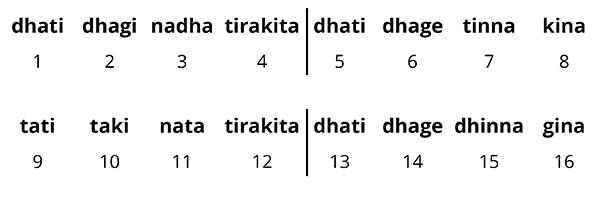Kāyadā – कायदा
Quick Definition: The most important theme-and-variation form of classical tabla, essential for developing both technique and fluency with the language. Performed mostly in tabla solo, and occasionally in accompaniment.
Literal meaning: rule; system of rules; method
Kayda Example:
Dilli Kayda in Tintal (16 beats)

Spoken Two Times:
Played in single and double speeds:
(from Dilli Kayda 2)
Introduction to Kayda
Of all compositional forms, the kayda is arguably the most important in the modern classical tradition. Tabla students will likely know more kaydas—and spend more time practicing them—than any other form.
This is because kaydas are the best source for learning both the classical language and the tabla’s techniques. But also because kayda practice teaches students how to improvise, one of the most important skills of this challenging tradition.
And for listeners, no other single form will teach you more about classical tabla; the kayda is both the most pure theme-and-variation form, and the best example of the cyclic form, which we hear throughout the classical repertoire.
Because of its importance, we explore the kayda in depth in the following sections:
The rest of this section gives a general introduction to the kayda, and outlines the sections which follow.
Kayda Background
Like so much of the tabla repertoire, the history of the kayda is vague. But it is widely believed that the kayda form originated in the Dilli gharana. And until today, the Dilli and Ajrara gharanas are known for their wide and beautiful variety of kaydas (Ajrara is considered a close relative of Dilli).
In the past, kaydas were less common in other gharanas. But over time, all major gharanas adopted Dilli kaydas and developed their own.
In the modern era, most tabla lineages possess a large body of kaydas, giving us countless different examples and styles. Many of the most well known kaydas are shared by all.
The kayda is a cyclic form
A cyclic structure is one that reflects the basic structure of the tal (the cycle). And all kaydas have the same basic cyclic structure.
Once you are familiar with the underlying structure of the kayda, you will easily recognize it in other forms, such as the rela, bant, peshkar, and gat-kayda.
And in performance, tabla players are usually performing in one of two modes: cyclic or cadential, with cyclic being the more common.
So understanding this cyclic quality is essential to understanding a large part of classical tabla. And the kayda is the clearest, most consistent example of the cyclic form.
We look at the cyclic quality of kaydas in the next section, The Structure of Kaydas.
The kayda is a system
The word kayda has various related translations. Two of them are "system of rules" and "method". Both of these meanings can help you understand that the kayda is more than a compositional form; it is also a system of practice and improvisation.
Kayda practice teaches at least two things very well:
- The foundational bols (phrases and techniques) of tabla
- How to manipulate those bols into new compositions (variations)
Both of these are major areas of development which take years to master.
Kayda Phrases
The foundational bols (strokes and phrases) of kaydas are like building blocks of the language, and are found in many other kinds of compositions.
If you study the relatively small number of Dilli and Benares kaydas on this website, you will find many phrases from these compositions repeated in countless other compositions, but in surprisingly different and creative ways.
By focusing on these phrases, students are also mastering essential fingering techniques. For this reason, when a teacher sees a weakness in a student’s hand, he will often give just the right kayda to correct that particular technique.
We look at kayda phrases in the Kayda Phrases section.
Kayda Variations
With kayda variations, we can understand why the kayda is rightly called a theme-and-variation form. And seeing how variations are created helps us understand the kayda as a system.
This system is not only effective, but also highly intuitive in its understanding of how fluency and improvisation can be developed.
In terms of pedagogy, the kayda may be classical tabla’s greatest achievement.
We look at kayda development in the Kayda Variations section.
References
Kippen, James. The Tabla of Lucknow – A Cultural Analysis of a Musical Tradition. Cambridge: Cambridge University Press, 1988.
Misra, Chhote Lal. Tal Prabandh. New Delhi: Kanishka Publishers, 2006. (Hindi)
Stewart, Rebecca Marie. The Tabla in Perspective. Unpublished Ph.D. thesis, University of California, Los Angeles, 1974.